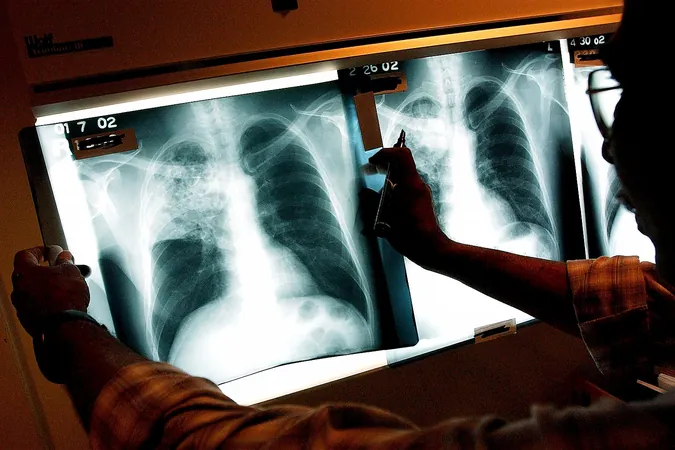
Tuberculosis Sees Unsettling Resurgence in the U.S.: What You Must Know Now!
2025-03-28
Author: Wei
Introduction
Tuberculosis (TB), once relegated to the annals of medical history, is inching its way back into public consciousness. After decades of decline, incidences of TB started to climb again in the U.S. in 2020, with alarming rates reaching their highest levels since 2011. In fact, a TB outbreak in Kansas that began in January 2024 has already seen over 100 infections and sadly, two fatalities. This is not just a U.S.-specific issue; in Europe, childhood TB infections surged by 10% in 2023, resulting in more than 7,500 cases. Coincidentally, with World Tuberculosis Day upon us and the recent release of author John Green's latest book, “Everything Is Tuberculosis,” the disease, often dismissed as a relic of the past, has been thrust back into the limelight.
The Grim Reality
The grim reality, however, is that TB has never completely disappeared. It remains the deadliest infectious disease worldwide, claiming more than a million lives annually. While COVID-19 temporarily eclipsed TB’s notoriety, the latter reclaimed its infamous title of the leading infectious killer in 2022.
Current Status in the U.S.
In the U.S., TB is classified as largely under control, but it poses a grave threat in regions like Southeast Asia and Africa. Existing treatments for TB are effective, yet recent federal cuts to foreign aid mean that countless individuals worldwide will struggle to access necessary treatment, exacerbating an already perilous situation. Dr. William Schaffner, a professor of infectious diseases at Vanderbilt University Medical Center, emphasizes, "We can cure virtually everyone with tuberculosis," yet access to that treatment is diminishing. This negligence ultimately compromises public health, increasing the risk for Americans who have been fortunate enough to remain unbothered by TB's threat.
Why the Surge in U.S. Cases?
Amid global unrest—whether due to conflicts, migration, or public health crises—transmission rates of TB increase. As Schaffner succinctly puts it, "If populations are in turmoil, public health breaks down," leading to a breakdown in TB control programs. The halt of public health initiatives during the COVID pandemic devastated TB control measures, prolonging treatments and amplifying transmission rates.
Understanding Tuberculosis
Many might wonder: What exactly is tuberculosis? Often glamorized in literature and film as a "romantic" affliction, TB is, in reality, a slow, devastating disease. It is caused by bacteria that can lie dormant within the human body, sometimes for decades without causing symptoms—a phase known as latent infection. Although latent TB is not contagious, it can transition to an active infection, making individuals quite contagious and potentially leading to severe health complications, such as lung collapse.
Treatments and Challenges
Fortunately, TB is treatable and preventable. However, the treatment protocol is far from simple; it typically requires a six-month regimen of multiple drugs. Using a solitary drug risks the development of drug-resistant TB—an alarming public health crisis. The challenge is exacerbated by recent funding cuts from the U.S. Agency for International Development, which supports critical TB control programs.
Vaccines and Prevention
While a vaccine exists, its effectiveness dramatically declines for adults. It's primarily beneficial for infants and young children in high-prevalence nations. Researchers strive for a better vaccine, with experts like Schaffner affirming that new options would be monumental achievements in combating the disease.
Testing for Latent TB
The ideal scenario is detecting latent TB before it becomes active. Screening programs in each state aim to find individuals with latent TB, enabling preemptive treatment. Testing is relatively simple, involving either a skin test or a modern blood test, making it accessible for those at risk.
The Importance of Vigilance
If you're situated near the outbreak in Kansas, public health authorities might reach out for testing—it's vital to comply for your safety and that of the community. In most of the U.S., mass TB testing isn't necessary due to the low incidence of tuberculosis, yet specific populations—including those in low-income areas, incarcerated individuals, and people with HIV—are at a higher risk and should prioritize screening.
Global Responsibility
While the U.S. enjoys relative safety from TB, the rising global infection rates demand our attention. As Schaffner pointedly states, "Germs don’t need a passport." Infectious diseases can traverse borders rapidly; COVID-19 provided a vivid illustration of this reality. As the world’s wealthiest nation, the U.S. has an ethical obligation to support global TB initiatives. Ignoring this responsibility could lead to increased local outbreaks in the future.
The cuts to TB funding are bound to have disastrous consequences worldwide. The World Health Organization has long highlighted the outrage of TB's ongoing prevalence in a world where effective tools for prevention and treatment exist. Without immediate action, TB could spiral out of control, not just abroad but domestically as well.
Conclusion
Stay informed and ensure you take the necessary steps to protect yourself and your community. Awareness and action are our greatest allies in the fight against tuberculosis!




 Brasil (PT)
Brasil (PT)
 Canada (EN)
Canada (EN)
 Chile (ES)
Chile (ES)
 Česko (CS)
Česko (CS)
 대한민국 (KO)
대한민국 (KO)
 España (ES)
España (ES)
 France (FR)
France (FR)
 Hong Kong (EN)
Hong Kong (EN)
 Italia (IT)
Italia (IT)
 日本 (JA)
日本 (JA)
 Magyarország (HU)
Magyarország (HU)
 Norge (NO)
Norge (NO)
 Polska (PL)
Polska (PL)
 Schweiz (DE)
Schweiz (DE)
 Singapore (EN)
Singapore (EN)
 Sverige (SV)
Sverige (SV)
 Suomi (FI)
Suomi (FI)
 Türkiye (TR)
Türkiye (TR)
 الإمارات العربية المتحدة (AR)
الإمارات العربية المتحدة (AR)